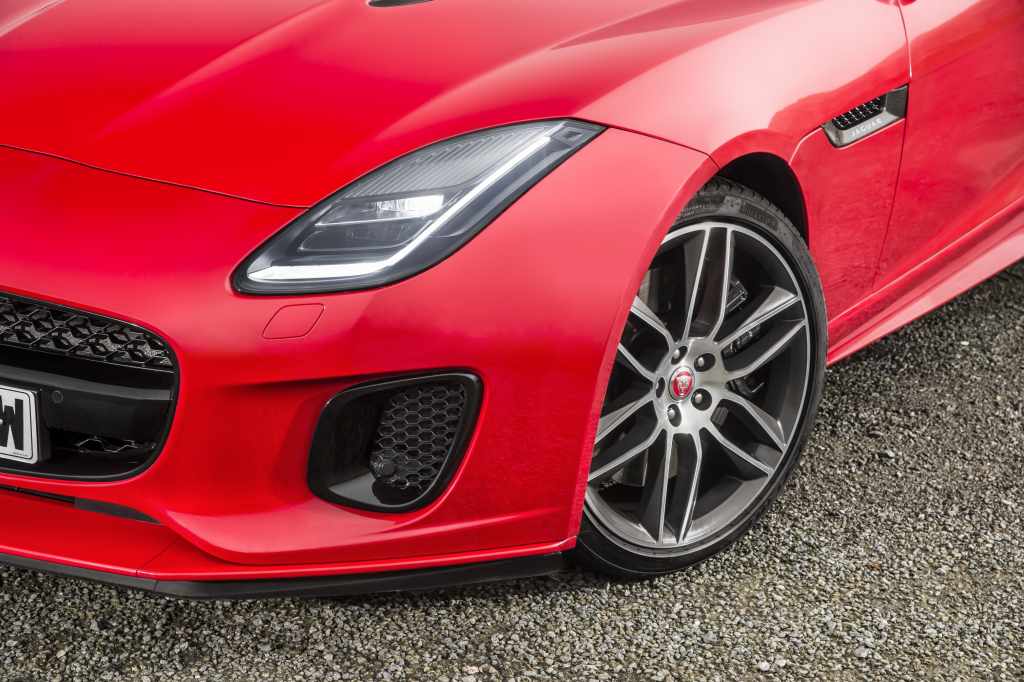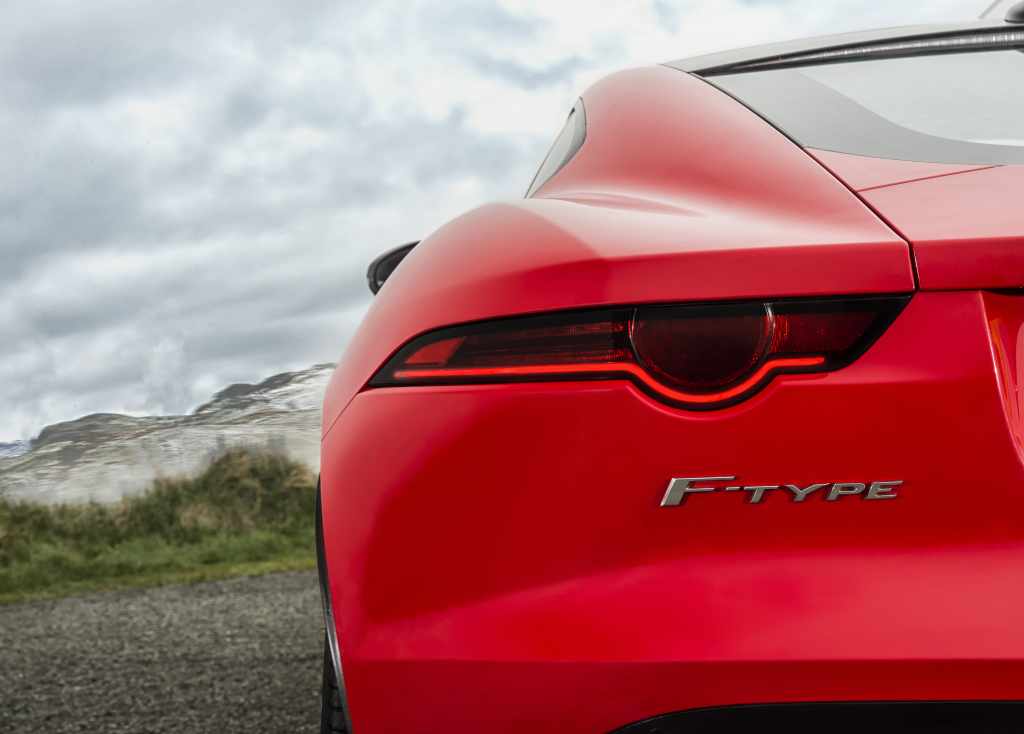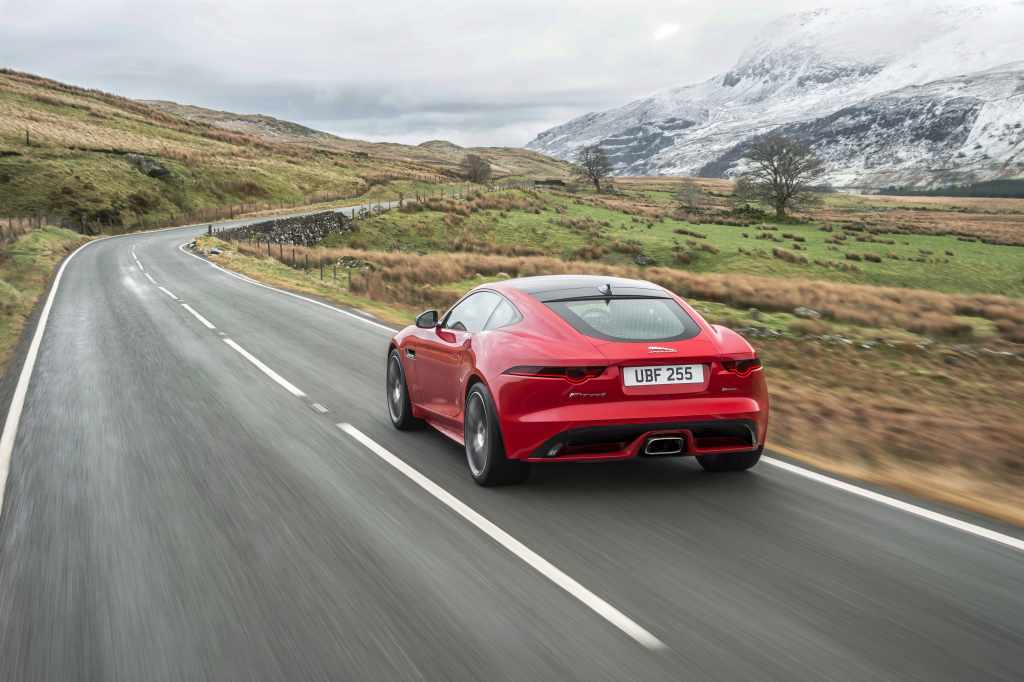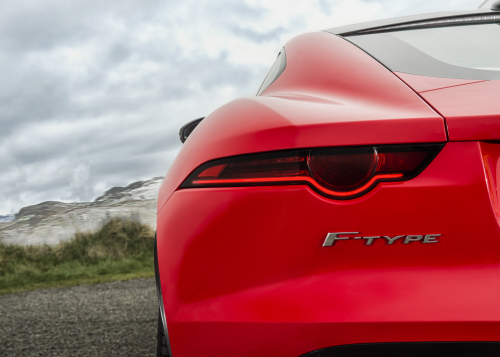- New Jaguar F‑TYPE gains turbocharged four‑cylinder Ingenium petrol engine
- A true Jaguar sports car and a true F‑TYPE, with its own unique character
- New 300PS 2.0‑litre is the most powerful four‑cylinder ever in a production Jaguar
- New F‑TYPE four‑cylinder goes on sale from spring 2017, priced from £49,900 (market dependent)
- Acceleration from 0‑60mph takes just 5.4 seconds, maximum speed 155mph
- Fuel consumption reduction of more than 16 per cent compared to the 340PS V6, and with CO2 emissions of just 163g/km
- Weight reduction of 52kg and bespoke chassis tuning delivers even greater agility
- Maximum torque of 400Nm together with 8‑speed Quickshift transmission delivers excellent response throughout the rev range
- Intake and exhaust meticulously tuned to deliver renowned F‑TYPE sound
- Enhanced suite of driver assistance systems including Autonomous Emergency Braking, Traffic Sign Recognition, Adaptive Speed Limiter and Lane Keep Assist

Jaguar F-TYPE Bloodline
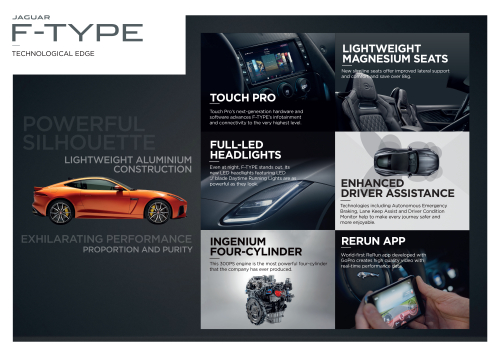
Jaguar F-TYPE Design

Jaguar F-TYPE Technology Engineering
Summary
Jaguar is broadening the appeal of the new F‑TYPE with the introduction of the state‑of‑the‑art four‑cylinder Ingenium petrol engine. The award winning F‑TYPE family now spans from the entry‑level four‑cylinder model to Jaguar’s 200mph all‑weather supercar – the F‑TYPE SVR.
The pairing of Jaguar’s all‑aluminium two‑seat sports car with the advanced 300PS 2.0‑litre turbocharged powerplant delivers Jaguar sports car DNA with enhanced agility and improved efficiency and affordability. This is a true F‑TYPE, with its own unique character.
The new model retains the performance expected from the F‑TYPE, and can accelerate from
0‑60mph in only 5.4 seconds and achieve a top speed of 155mph. The turbocharged engine’s high maximum torque of 400Nm, generated from just 1,500rpm, together with the eight‑speed Quickshift transmission, delivers exceptional response throughout the rev range.
Not only is the 300PS Ingenium engine the most powerful four‑cylinder unit ever offered in a production Jaguar, it also generates the highest specific power output of any engine in the F‑TYPE range: 150PS per litre. It also makes this the most efficient F‑TYPE in the range, with a 16 per cent improvement in fuel economy over the 340PS V6, together with CO2 emissions of just 163g/km on the European combined cycle.
Introducing our advanced four‑cylinder engine to F‑TYPE has created a vehicle with its own distinct character. Performance from an engine of this size is remarkable and is balanced with improved fuel efficiency and affordability, making the F‑TYPE experience more accessible than ever before.
Ian Hoban
Vehicle Line Director, Jaguar F‑TYPE
A host of advanced technologies enables the Ingenium engine to deliver this blend of high performance and low fuel consumption. Neatly integrated into the cylinder head is a state‑of‑the‑art electrohydraulic valvetrain featuring patented control algorithms developed in‑house. This technology enables fully variable control of intake valve lift for optimum power, torque and efficiency throughout the engine’s operating range.
The exhaust manifold is integrated into the cylinder head casting. Coolant flowing through ducts in the manifold reduces warm‑up times and therefore reduces fuel consumption and emissions. The manifold is carefully matched to a twin‑scroll turbocharger. The design prevents exhaust gas pulsation interference, ensuring that the turbine wheel responds far more quickly: boost pressure is delivered near‑instantaneously, making turbo lag almost non‑existent, providing the responsiveness so familiar to the F‑TYPE driving experience.
To ensure the best possible launch performance and transient response while still enabling the engine to develop its high peak power output, the turbocharger features ceramic ball bearings. These deliver the lowest possible bearing friction, especially from cold starts.
The 200bar direct injection system features centrally‑mounted fuel injectors. Together with optimised spray patterns this technology helps to minimise fuel impingement on the cylinder walls and the piston crowns, improving efficiency and reducing emissions.
Like all members of the Ingenium family, the F‑TYPE’s 300PS powerplant was designed and developed in‑house. It is manufactured in the UK at Jaguar Land Rover’s £1billion Engine Manufacturing Centre, alongside the 200PS and 250PS four‑cylinder petrol engines, and the 150PS, 163PS, 180PS and 240PS four‑cylinder diesels.
The Ingenium engine contributes to an overall vehicle weight reduction of 52kg – most of which is over the front axle – and this is key to the four‑cylinder F‑TYPE’s enhanced agility. Meticulous tuning of the chassis to complement the new engine delivers even greater steering response, body control and ride comfort.
The introduction of the four‑cylinder does not mean that drivers lose out on aural feedback or reward: these have always been an essential part of the F‑TYPE’s appeal, and have not been compromised. A meticulously‑tuned active exhaust is standard on entry‑level F‑TYPE models, while the R‑Dynamic variants feature a switchable active exhaust for an even more involving driving experience.
Most of the weight reduction is over the front axle, making the car beautifully balanced and really agile to drive – as you’d expect, the car is really at home on beautiful twisty roads. Couple that with a four‑cylinder exhaust note and this particular F‑TYPE has a character all of its own. I like to think of it as the feisty younger brother of the V6 and V8 models.
Erol Mustafa
Chief Product Engineer, Jaguar Sports Cars
The 2018 Model Year Jaguar F‑TYPE features visual enhancements to give the sports car an even more powerful presence. Redesigned bumpers, together with optional full LED headlights enhance the F‑TYPE’s award‑winning design and provide greater differentiation between each model in the range.
At the rear the four‑cylinder model features a unique single tailpipe finisher to distinguish it from the twin central exhausts and quad outboard exhausts of the V6 and V8 models. Lightweight 18‑inch wheels also identify the latest addition to the line‑up, and help to minimise unsprung mass, contributing to the enhanced ride and handling.
The changes to the F‑TYPE’s interior, including lightweight slimline seats, Touch Pro infotainment system and new chrome and aluminium trim finishers, heighten the driver‑focused feel. A sleek frameless rearview mirror adds another contemporary touch.
Retaining the silhouette of F‑TYPE across the model range is really important to us whether it’s the 200mph SVR or the new 2.0‑litre four‑cylinder. This is a true Jaguar sports car and a true F‑TYPE – we didn’t want to dilute the design DNA. Even so, this car has its own unique character, and the new single tailpipe finisher exemplifies this.
Ian Callum
Director of Design, Jaguar
The new F‑TYPE range also offers a wider range of advanced driver assistance systems underpinned by the integration of a highly sophisticated forward‑facing stereo camera. These systems help to improve safety and reduce driver workload, and include Autonomous Emergency Braking and Lane Departure Warning as standard, and optional Lane Keep Assist, Traffic Sign Recognition, Adaptive Speed Limiter and Driver Condition Monitor.
The new F‑TYPE range consists of:
F‑TYPE Coupé and Convertible:
300PS 2.0‑litre four‑cylinder; Quickshift RWD
340PS 3.0‑litre V6; Quickshift RWD/ manual RWD
380PS 3.0‑litre V6; Quickshift; RWD/ AWD, manual RWD
F‑TYPE R‑Dynamic Coupé and Convertible:
300PS 2.0‑litre four‑cylinder; Quickshift RWD
340PS 3.0‑litre V6; Quickshift RWD/ manual RWD
380PS 3.0‑litre V6; Quickshift; RWD/ AWD, manual RWD
F‑TYPE 400 SPORT Coupé and Convertible:
400PS 3.0‑litre V6; Quickshift RWD/ AWD
F‑TYPE R Coupé and Convertible:
550PS 5.0‑litre V8; Quickshift AWD
F‑TYPE SVR Coupé and Convertible:
575PS 5.0‑litre V8; Quickshift AWD
POWERTRAIN
Jaguar Land Rover’s new 2.0‑litre 300PS Ingenium petrol engine is the most powerful four‑cylinder engine that the company has ever produced. Featuring a suite of state‑of‑the‑art technologies, it delivers exceptional performance, refinement and efficiency
The powerful all‑aluminium Ingenium petrol engine is the perfect match for the all‑aluminium F‑TYPE, and expands the powertrain line‑up from 300PS four‑cylinder up to 575PS V8 – a breadth of performance unrivalled in the sports car segment.
Just like the supercharged six‑ and eight‑cylinder engines, the turbocharged four‑cylinder delivers the driving experience promised by the F‑TYPE’s award‑winning design, but with new levels of efficiency. Generating 150PS per litre, it has the highest specific power output of any engine in the new F‑TYPE range.
Offered exclusively with rear‑wheel drive and a specifically‑optimised eight‑speed Quickshift transmission, the four‑cylinder enables fuel consumption and CO2 emissions on the European combined cycle of 39.2mpg (7.2‑litres/100km) and 163g/km respectively.
The 300PS Ingenium petrol engine is engineered to deliver a compelling blend of performance, refinement and efficiency. Cutting‑edge technologies including electrohydraulic intake valve lift control, integrated exhaust manifold and a twin‑scroll turbocharger with ceramic ball bearings make this the most advanced petrol engine we’ve ever produced.
Not only is this the most powerful four‑cylinder ever offered in a production Jaguar, it also develops the highest specific power and torque ratings of any engine in the F‑TYPE range. It’s a natural fit for a Jaguar sports car.
Ron Lee
Engineering Director of Powertrain, Jaguar Land Rover
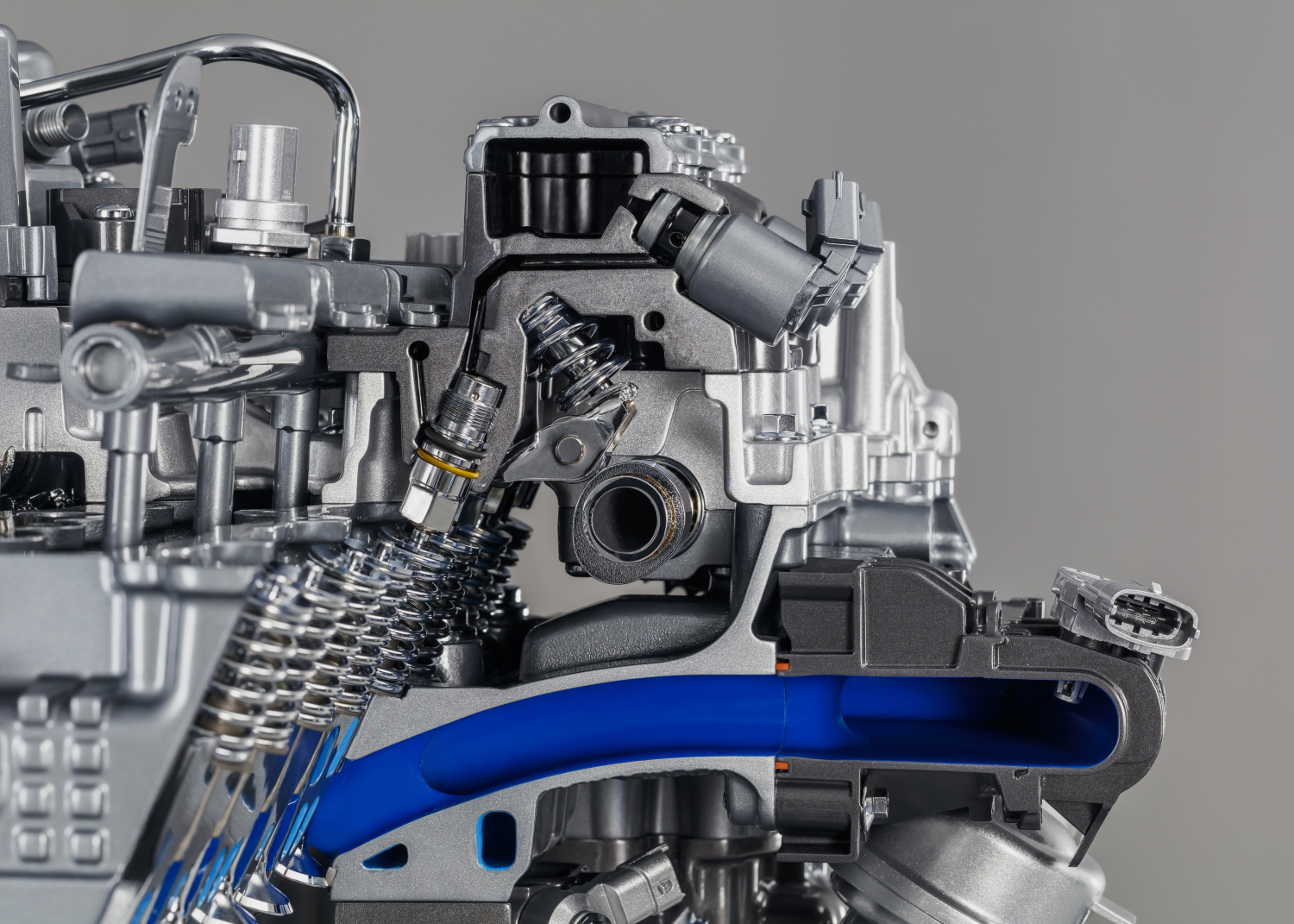
The new Jaguar F-Type four-cylinder: A pure sports car
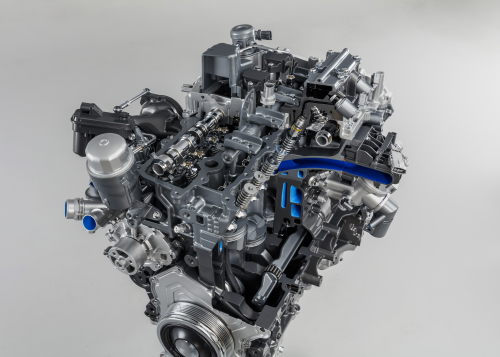
The new Jaguar F-Type four-cylinder: A pure sports car

The new Jaguar F-Type four-cylinder: A pure sports car

The new Jaguar F-Type four-cylinder: A pure sports car
Neatly integrated into the cylinder head is a state‑of‑the‑art electrohydraulic valvetrain featuring patented control algorithms developed in‑house. This technology enables fully variable control of intake valve lift for optimum efficiency, power and torque throughout the engine’s operating range.
Most petrol engines use a throttle valve for load control, but this method increases pumping losses and therefore increases fuel consumption. And, it takes time for the charge air to fill the intake manifold: this delay means that ignition timing must be retarded accordingly to improve response, with a negative impact on response and efficiency.
Ingenium petrol engines use a different approach: load control is managed primarily by the intake valves themselves by varying the amount of lift, and the duration for which they are open. To achieve this, the intake cams no longer operate the valves directly: instead they actuate compact hydraulic pumps via low‑friction roller finger followers. The oil pressure generated in these pumps is then used to open and close the intake valves.
Each pump is actuated by a solenoid valve, and highly sophisticated software is used to control the solenoids. When the solenoids are fully open, there’s no valve lift; when they’re closed, full lift is achieved. Varying the solenoid’s state delivers fully variable valve lift – anywhere between 0 and 11mm – for optimised intake air flow throughout the engine’s full operating range.
Ingenium’s electrohydraulic technology is fast enough to deliver cycle‑by‑cycle control of the combustion process, and, combined with phasers on the intake and exhaust cams delivers even greater flexibility.
Late intake valve opening is used during engine start‑up: the combination of low valve lift and short duration provides precise control of the exact amount of air required, especially during cold starts.
At very low speeds and loads, the flexibility of the valvetrain enables the so‑called composite mode – a combination of early intake valve closing and late intake valve opening – which delivers enhanced charge motion and therefore more complete and efficient combustion.
At part‑load conditions, such as low‑speed driving in urban areas or when cruising on the motorway, the valvetrain operates an early intake valve closing strategy combined with a later exhaust valve opening, which delivers optimum efficiency due to the increased expansion ratio. Dual independent cam phasing allows optimal residual gas control with minimal frictional losses. The combination of turbocharging and the highly efficient watercooled charge air cooler means that the charge density remains high, maintaining torque output and ensuring that the engine can always respond immediately to the driver’s demands.
Under full load the system delivers full valve lift and longer duration, combined with an earlier exhaust valve opening to enable maximum air flow, allowing the engine to provide full performance.
Performance, response and efficiency: advanced turbocharger technology
In a first for Jaguar Land Rover, the exhaust manifold is integrated into the cylinder head casting. Coolant flowing through ducts in the manifold reduces warm‑up times and therefore reduces fuel consumption and emissions.
The integrated exhaust manifold can also reduce maximum exhaust gas temperatures and therefore the need for enrichment at high load, delivering further efficiency improvements – not only on the official test cycle but also in real‑world driving.
The manifold is carefully matched to a twin‑scroll turbocharger. For maximum efficiency the duct inside the water‑cooled turbine housing is divided in two, with one fed by exhaust gas from cylinders one and three, the other by cylinders two and four.
This arrangement prevents exhaust gas pulsation interference, ensuring that the turbine wheel responds far more quickly: boost pressure is delivered near‑instantaneously, making turbo lag almost non‑existent, providing the responsiveness so familiar to the F‑TYPE driving experience.
To ensure the best possible launch performance and transient response while still enabling the engine to develop its high peak power output, the turbocharger features ceramic ball bearings – a first for a Jaguar Land Rover petrol engine. These deliver the lowest possible bearing friction, especially from cold starts.
Cleaner combustion: inherently low emissions
The Ingenium engine also features a new 200bar direct injection system. The injectors are centrally‑mounted: together with optimised spray patterns this configuration helps to minimise fuel impingement on the cylinder walls and the piston crown, improving efficiency and reducing emissions.
The inlet ports deliver high levels of charge motion which, together with the enhancements made to the direct injection system, further reduces wall wetting and promotes greater mixing of the fuel and air for more efficient combustion.
Efficient by design
All Ingenium engines deliver benchmark low levels of friction, contributing to inherently good efficiency and refinement. Design features which contribute to this are cylinder bores offset by 12mm to reduce tangential forces acting on the cylinder walls, and needle roller bearings for the twin balancer shafts and camshafts.
The map‑controlled oil pump matches flow rate according to engine speed, load and temperature, and the switchable piston cooling jets only spray oil onto the underside of the piston crowns when required, further reducing load on the lubrication system.
The split cooling system with map‑controlled electric coolant pump ensures rapid engine warm‑up by only circulating coolant through the block once the engine comes up to temperature. As well as reducing fuel consumption this also improves passenger comfort because the heater can warm the
F‑TYPE’s cabin more quickly.
CHASSIS
The four‑cylinder F‑TYPE shares the dynamics DNA of the V6 and V8 models but the introduction of the Ingenium engine together with a bespoke chassis tune make it the lightest and most agile yet
From day one the F‑TYPE was engineered to provide outstanding agility and response without compromising the day‑to‑day usability and ride comfort expected from all Jaguar cars.
The stiff, light aluminium bodystructure and all‑round aluminium double wishbone suspension have always been fundamental to delivering that duality of character. Now, the development team has meticulously tuned the chassis to take full advantage of the additional weight savings offered by the new four‑cylinder engine.
We wanted the power and efficiency of the new four‑cylinder engine to be matched by levels of responsiveness that would make the F‑TYPE driving experience even more engaging and rewarding. The result of the intensive development process is an even better balance, an even more connected feel, and enhanced ride comfort. Enthusiasts will want to drive this car: this is a true F‑TYPE, with its own unique character.
Mike Cross
Chief Engineer, Vehicle Integrity, Jaguar Land Rover
Weighing 52kg less than the equivalent model powered by the 340PS V6, this is the lightest F‑TYPE yet. The majority of this mass reduction is located over the front axle, delivering maximum benefit to vehicle dynamics, and improved weight distribution – the balance moves one percentage point to the rear.
The front and rear spring rates have been reduced by four and three per cent respectively to suit the reduction in corner weights. The valving of the monotube dampers incorporates learning from the
F‑TYPE SVR programme: meticulous tuning delivers enhanced ride comfort while maintaining the required handling character.
The F‑TYPE’s electric power‑assisted steering system – already a benchmark for feel and response – has a unique calibration for the four‑cylinder model to extract the full benefit of the weight savings and delivers improved tactility and feedback. Together with the Torque Vectoring system – which can apply precisely‑controlled braking of the inner wheels during cornering to mitigate understeer – the changes make the F‑TYPE even more engaging and enjoyable to drive.
The entry‑level four‑cylinder models are equipped as standard with new, lightweight 18‑inch wheels fitted with 245/45/R18 tyres at the front axle and 275/40/R18 tyres at the rear: these help to reduce unsprung mass, further improving responsiveness and control.
The R‑Dynamic models have 19‑inch wheels as standard with 245/40/R19 and 275/35/R19 tyres front and rear respectively. All four‑cylinder F‑TYPE models can be specified with a range of optional 19‑ and 20‑inch wheel designs.
As standard, the braking system on all four‑cylinder models has 355mm and 325mm discs at the front and rear respectively and provides impressive stopping power. As an option, all four‑cylinder models fitted with 19‑ and 20‑inch wheels can be upgraded to the Jaguar Super Performance Braking System which features 380mm and 376mm discs.
ADVANCED DRIVER ASSISTANCE SYTEMS
The new F‑TYPE offers a suite of technologies designed to help and support the driver and make every journey easier, safer and more enjoyable
The new F‑TYPE is the latest Jaguar to feature a forward‑facing stereo camera: this state‑of‑the‑art vision sensor is at the heart of its new advanced driver assistance systems. One of the most important is the standardised Autonomous Emergency Braking system: if the system’s controller determines that a collision with the vehicle ahead is imminent, full braking is initiated automatically, helping to avoid the collision, or to mitigate its effects.
The stereo camera also provides the intelligence for the Lane Departure Warning (LDW ‑ standard) and Lane Keep Assist (LKA ‑ optional) systems. By monitoring the vehicle’s position relative to lane markings either side, LDW can help to prevent drivers from inadvertently leaving their lane by triggering a visual warning in the instrument cluster and a haptic warning through the steering wheel rim.
LKA provides the next level of assistance and can guide the driver back towards the centre of their lane by applying a small amount of counter‑steering through the electric power‑assisted steering system. The torque applied to the steering wheel can be easily over‑ridden, making the system intuitive in operation.
The optional Traffic Sign Recognition (TSR) system uses the stereo camera to keep the driver informed of the speed limit – including temporary limits which apply in road works, for example – and the variable limits used on some motorways. The limit is displayed in the instrument cluster, and camera data is always cross‑referenced against GPS data for maximum robustness.
Further support for the driver comes from the optional Adaptive Speed Limiter (ASL). This intelligent system uses TSR system data to adjust the set point and can automatically increase or decrease the vehicle's maximum speed while the accelerator pedal is pressed. If the TSR system recognises a higher speed limit ahead, ASL notifies the driver and can smoothly accelerate the vehicle up to the new limit. If the speed limit is lower, the vehicle can coast down accordingly.
Driver fatigue is a common cause of vehicles drifting out of lane. The F‑TYPE’s optional Driver Condition Monitor system can recognise patterns typical of driving when tired, including periods of little or no steering activity followed by sudden or excessive inputs, and can show a multi‑stage warning in the instrument cluster and give audible warnings to prompt the driver to take a break.
TECHNICAL DATA
|
|
F‑TYPE 300PS Coupé |
F‑TYPE 300PS Convertible |
|
ENGINE & TRANSMISSION |
|
|
|
Engine capacity (cc) |
1,997 |
|
|
Cylinders |
Four in‑line |
|
|
Valves per cylinder |
4; DOHC, dual independent variable cam timing, |
|
|
Bore/ stroke (mm) |
83.0/ 92.4 |
|
|
Compression ratio |
9.5:1 |
|
|
Fuel injection |
200bar direct injection |
|
|
Boosting system |
Single twin‑scroll turbocharger with ceramic ball bearings |
|
|
Power PS (kW) |
300 (221) @ 5,500rpm |
|
|
Torque Nm (lb ft) |
400 (295) @ 1,500‑4,500rpm |
|
|
Transmission |
8‑speed Quickshift |
|
|
Gear ratios (:1) |
|
|
|
1st |
4.714 |
|
|
2nd |
3.143 |
|
|
3rd |
2.106 |
|
|
4th |
1.667 |
|
|
5th |
1.285 |
|
|
6th |
1.000 |
|
|
7th |
0.839 |
|
|
8th |
0.667 |
|
|
Reverse |
3.295 |
|
|
Final Drive ratio |
3.55 |
|
|
CHASSIS |
|
|
|
Front suspension |
Double wishbone |
|
|
Rear suspension |
Double wishbone |
|
|
Front brakes |
Twin‑piston sliding caliper; 355mm ventilated discs |
|
|
Rear brakes |
Single‑piston sliding caliper; 325mm ventilated discs |
|
|
Steering |
Rack‑and‑pinion; electromechanical |
|
|
DIMENSIONS |
|
|
|
Length (mm) |
4,482 |
4,482 |
|
Width inc./ excl. mirrors (mm) |
2,042/ 1,923 |
2,042/ 1,923 |
|
Height (mm) |
1,310 |
1,307 |
|
Wheelbase (mm) |
2,622 |
2,622 |
|
Track front/ rear (mm) |
1,597/ 1,649 |
1,597/ 1,649 |
|
Weight (kg) |
From 1,525 |
From 1,545 |
|
Boot volume (litres) |
310/ 408 with/ without parcel tray |
207 |
|
Fuel tank (useable) litres |
63 |
63 |
|
PERFORMANCE & |
|
|
|
0‑60mph (sec) |
5.4 |
5.4 |
|
0‑100km/h (sec) |
5.7 |
5.7 |
|
Top speed mph (km/h) |
155 (249) |
155 (249) |
|
Fuel consumption mpg |
39.2 (7.2) |
39.2 (7.2) |
|
CO2 emissions (g/km) |
163 |
163 |
Manufacturer’s figures; correct at time of going to press




